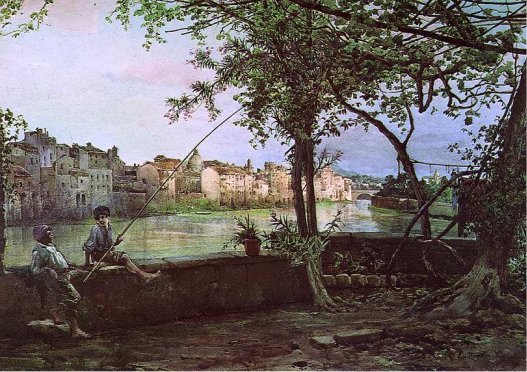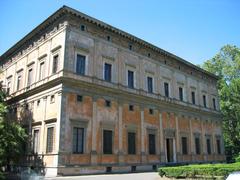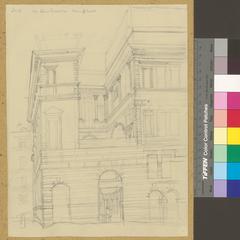
Villa Farnesina Rome: Visiting Hours, Tickets, and Historical Sites Guide
Date: 14/06/2025
Introduction
Villa Farnesina is a Renaissance masterpiece nestled in Rome’s lively Trastevere district. Commissioned by Agostino Chigi, one of the wealthiest bankers of the early 1500s, and designed by Baldassarre Peruzzi, the villa seamlessly blends architectural innovation, artistic genius, and the charm of its gardens. Adorned with celebrated frescoes by Raphael, Sebastiano del Piombo, Giulio Romano, and Il Sodoma, Villa Farnesina is both a showcase of High Renaissance art and a testament to Rome’s vibrant cultural past. Today, it is maintained by the Accademia Nazionale dei Lincei and welcomes visitors who wish to experience its tranquil atmosphere, remarkable art, and historical significance. For the latest information on visiting hours, tickets, and events, consult the official Villa Farnesina website.
Table of Contents
- Origins and Construction of Villa Farnesina
- Artistic Patronage and the Golden Age
- Transition to Farnese Ownership
- Architectural and Artistic Innovations
- Preservation and Modern Use
- Visiting Villa Farnesina: Hours, Tickets, and Visitor Information
- Cultural Significance and Legacy
- Frequently Asked Questions (FAQs)
- Related Rome Historical Sites
- Multimedia Gallery
- Plan Your Visit
Origins and Construction of Villa Farnesina
Built between 1506 and 1510, Villa Farnesina was commissioned by Agostino Chigi as a luxurious suburban retreat and a symbol of his status and cultural vision. Architect Baldassarre Peruzzi’s innovative U-shaped design marked a departure from the fortress-like palazzi of the era, embracing a harmony with nature and the surrounding gardens. The villa’s open loggias, grand halls, and integration with the landscape embodied the ideals of Renaissance humanism and offered a space for lavish social and intellectual gatherings (Villa Farnesina Official Website).
Artistic Patronage and the Golden Age
Chigi’s patronage attracted the greatest artists of the High Renaissance. Raphael and his workshop, along with Sebastiano del Piombo, Giulio Romano, and Il Sodoma, transformed the villa’s interiors into a vibrant celebration of classical mythology and Renaissance ideals. Raphael’s “Triumph of Galatea” and the “Cupid and Psyche” cycle are among the villa’s most celebrated frescoes, renowned for their dynamic compositions and mythological themes (Villa Farnesina: Picture Gallery).
Socially, the villa was famous for extravagant banquets and intellectual salons, where Chigi hosted Rome’s elite—often with spectacular events, such as guests arriving by boat after the Tiber was temporarily diverted.
Transition to Farnese Ownership
After Chigi’s death in 1520, the villa passed to his heirs and, in 1577, was acquired by Cardinal Alessandro Farnese. The Farnese family, a powerful Renaissance dynasty, renamed the villa “Farnesina” to distinguish it from their Palazzo Farnese across the Tiber. While the Farnese made few structural changes, the villa continued to play host to Rome’s aristocracy and cultural elite (Villa Farnesina: History).
Architectural and Artistic Innovations
Villa Farnesina is celebrated for its groundbreaking use of perspective and integration of art and architecture. In the Sala delle Prospettive (Hall of Perspectives), Peruzzi’s frescoes create optical illusions that extend the villa’s space outward. The Loggia of Cupid and Psyche features a series of frescoes by Raphael and his assistants, illustrating the myth of Cupid and Psyche and blending vivid storytelling with visual grandeur.
These artistic feats, combined with the villa’s harmonious relationship with its gardens, established a new model for aristocratic residences in Italy (Wikipedia).
Preservation and Modern Use
After changing hands several times—including ownership by the Bourbon kings of Naples and the Spanish ambassador—the villa was acquired in 1927 by the Accademia Nazionale dei Lincei. Today, Villa Farnesina functions as both a museum and a center for cultural research, with ongoing restoration projects and digital initiatives such as virtual tours (Villa Farnesina: Restorations). Recent discoveries, like the hidden Baroque frescoes by Carlo Maratta, underscore the villa’s evolving legacy.
Visiting Villa Farnesina: Hours, Tickets, and Visitor Information
Visiting Hours
- Regular Opening: Monday to Saturday, 9:00 AM – 2:00 PM (last entry 1:30 PM)
- Closed: Sundays (except for special openings)
- Special Openings: Second Sunday of each month, 9:00 AM – 5:00 PM (last entry 4:00 PM); guided tours and live music available on these days (Villa Farnesina Official Website).
Tickets and Discounts
- Standard Ticket: €10.00 (June 2025)
- Reduced Ticket: €8.00 (Colosseum Archaeological Park Membership holders)
- Special Offers: €10.00 for certain museum membership card holders; €1 discount with Vatican Museums ticket (within 7 days)
- Combined Offers: Present Villa Farnesina ticket within 3 months for reduced entry to the Colosseum archaeological area and Roman Forum–Palatine (€12.00)
- Children and Residents: Free or reduced rates for children under 18 and Rome residents; check official website for details
- Group Bookings: Groups over 10 must book via email ([email protected]); groups over 25 are split; radio microphones required
Accessibility
- The villa is accessible to visitors with mobility impairments, though some areas may be limited due to the historic structure. Notify staff in advance for elevator access (Condé Nast Traveler).
Guided Tours and Special Events
- Guided Tours: Saturdays at 10:00 AM (English) and 12:30 PM (Italian); extra tours during special openings.
- Private and Group Visits: Extraordinary visits available by request (minimum 15 days’ notice).
- Special Events: Temporary exhibitions and cultural events are regularly scheduled; consult official website for updates.
Facilities and Travel Tips
- Location: Via della Lungara, 230, Trastevere, Rome
- Transport: Bus lines 23, 280; short walk from Piazza Trilussa
- Facilities: Gift shop, restrooms available; no café on-site, but many options nearby
- Recommended Visit Duration: 1–1.5 hours
- Nearby Attractions: Basilica of Santa Maria in Trastevere, Janiculum Hill, Rome’s Botanical Garden (Romeing)
Photography Policy
- Non-flash photography is allowed throughout most of the villa; flash and tripods are prohibited. Always confirm current policies upon entry.
Cultural Significance and Legacy
Villa Farnesina remains a touchstone of Renaissance art, architecture, and culture. Its frescoes by Raphael and others, innovative design, and rich history as a social and intellectual hub continue to inspire scholars and visitors. The villa’s preservation by the Accademia Nazionale dei Lincei ensures its legacy as a living monument to human creativity and collaboration (Villa Farnesina: Linceian Center for Research on Cultural Heritage).
Frequently Asked Questions (FAQs)
Q: What are the best times to visit Villa Farnesina to avoid crowds?
A: Early weekday mornings and late afternoons outside peak tourist seasons offer the quietest experience.
Q: How do I buy tickets?
A: Tickets are available online or at the entrance; advance booking is recommended, especially for groups and special events.
Q: Is Villa Farnesina wheelchair accessible?
A: Yes, with advance notice; some historic areas may have limited access.
Q: Are guided tours available?
A: Yes, on Saturdays and during special openings in English and Italian; private tours can be arranged.
Q: Can I take photographs inside?
A: Non-flash photography is generally permitted.
Q: What else can I see nearby?
A: Trastevere’s vibrant streets, the Botanical Garden, Basilica of Santa Maria in Trastevere, and Janiculum Hill are all within walking distance.
Related Rome Historical Sites
Multimedia Gallery
Virtual Tour of Villa Farnesina
Plan Your Visit
Villa Farnesina encapsulates the pinnacle of Renaissance achievement in Rome. For a serene and enriching experience, plan ahead: check current visiting hours, book tickets online, and explore the villa’s art and gardens at your own pace. Enhance your visit with digital guides or the Audiala app for personalized tours and insider tips.
Continue your exploration of Rome’s historical gems by visiting nearby Trastevere sites and enjoying the vibrant local culture.
For more information and updates, consult the official Villa Farnesina website.
References
- Villa Farnesina Official Website (http://www.villafarnesina.it/?lang=en)
- Romeing: Villa Farnesina – A Renaissance Treasure in Trastevere
- Wikipedia: Villa Farnesina
- Condé Nast Traveler: Villa Farnesina – Rome



















































































































































































































































